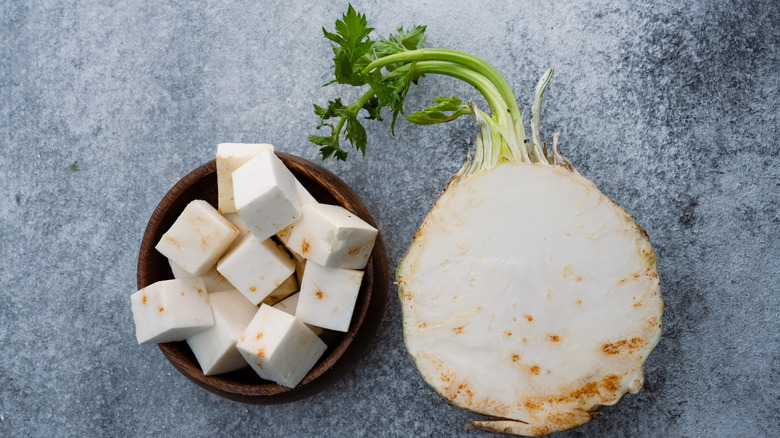
If you’re tired of well-trodden root vegetables like potatoes, carrots, or beets, then Gordon Ramsay has some advice for you: Try out celeriac (sometimes called celery root). In an interview with Bon Appétit, Ramsay dubbed this hulking white root veggie to be one of the most underrated foods. That may be because of its looks, he noted, calling it “one of the ugliest vegetables around” and “absolutely hideous-looking.”
Celeriac is very much a case of not judging a book by its cover, Ramsay suggests, as it works in salads, soups, and even as an alternative to standard potato fries. He has more than a few recipes that use celeriac, too. One keeps things simple: creamed celeriac, where it’s cooked, puréed, and mixed with cream. This one pairs with an even more uncommon root vegetable: Salsify. This long vegetable is related to the turnip; Ramsay sautés it with onion and butter until it’s brown. He’s also whipped up a celeriac Wellington. While there isn’t a recipe for it, it seems to take the classic beef Wellington (beef and mushrooms wrapped up in pastry) and substitute creamy celeriac for the beef in the center. Ramsay seems to be a fan of using celeriac as a meat substitute in classic recipes: Another idea is a lasagna with puréed celeriac in place of the meat and sliced celeriac for the pasta. He recommends it as a side dish.
What else to know about celeriac or celery root

As its alternate name celery root implies, celeriac is — surprise — the root bulb of the celery plant. It’s quite large compared to other root vegetables, roughly the size of a grapefruit with a roundish shape that’s white with brown nubs on it.
Celeriac is in season in late fall and winter. Thanks to its relation to celery, you’ll find that its flavor overlaps with its above-ground cousin, although with more earthy notes. Opinions vary on its exact taste: Some say it has some parsnip hints, while others think it has more of a tangy kick like turnip. To prepare it, you’ll usually want to chop off the ends and peel it, as the rough exterior isn’t that pleasant. Don’t peel it far in advance, as it starts to discolor quickly.
Celeriac is often considered a pretty versatile veggie that can be used both raw and cooked. One classic dish on the raw side is French-style céleri remoulade, in which celeriac is peeled, grated, and mixed in with mustard, mayo, horseradish, and capers, a bit like a tangy coleslaw. When cooked, it can go many places where potatoes would be used, like mashes and gratins. However, be warned that it has much less starch, so when mashed up, it won’t thicken the same way potatoes do. Alternatively, keep things simple and roast it until it’s crisp alongside other root vegetables, with olive oil, salt, and whatever seasonings you fancy.
